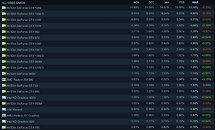- Joined
- Mar 25, 2009
- Messages
- 9,832 (1.68/day)
- Location
- 04578
| System Name | Old reliable |
|---|---|
| Processor | Intel 8700K @ 4.8 GHz |
| Motherboard | MSI Z370 Gaming Pro Carbon AC |
| Cooling | Custom Water |
| Memory | 32 GB Crucial Ballistix 3666 MHz |
| Video Card(s) | MSI RTX 3080 10GB Suprim X |
| Storage | 3x SSDs 2x HDDs |
| Display(s) | ASUS VG27AQL1A x2 2560x1440 8bit IPS |
| Case | Thermaltake Core P3 TG |
| Audio Device(s) | Samson Meteor Mic / Generic 2.1 / KRK KNS 6400 headset |
| Power Supply | Zalman EBT-1000 |
| Mouse | Mionix NAOS 7000 |
| Keyboard | Mionix |
Steam's latest hardware survey has been released, and while there is no real head scratching changes, it does continue to give us a glimpse into current market trends. In regards to CPU adoption, both six-core and eight-core processors now account for 12.2% and 2.2% respectively. Looking at just Windows data shows six-core processors gained a bit over 2% market share in 3 months. Meanwhile, eight-core offerings saw a market share increase of roughly 0.5%. Speaking of processors, Intel still dominates the market capturing an 82% share. AMD, while competitive in many tasks besides gaming still only has an 18% share. Looking at the data would lead one to believe AMD is gaining back market share; however looking at previous hardware surveys their current share is mostly holding steady. Considering Intel still offers better gaming performance for the time being its unlikely AMD will make any real gains in the Steam hardware survey until gaming performance reaches true parity.
Looking at graphics cards, NVIDIA still reigns supreme holding the same 75% market share they have been clutching for quite some time. AMD, on the other hand, continues to struggle, holding a paltry 15% share with Intel and their integrated graphics still managing to hold a 10% share. Considering AMD's only release as of late was the Radeon VII it is not all that surprising to see no change here. That said, NVIDIA's dominance is indeed not a good thing as it means competition is minimal, and pricing is likely to remain high. Right now according to the Steam hardware survey, NVIDIA currently holds the first 12 spots in regards to today's most popular graphics cards, which combine for a 52.8% share. The most popular of these being the GTX 1060. You have to go all the way down to 13th place to find an AMD graphics card which just so happens to be the Radeon RX 580 with its 1.1% share. To find the next AMD graphics card you have to go all the way down to 19th where the companies Radeon R7 Graphics holds steady at 0.87%. Hopefully, AMD's upcoming Navi graphics architecture can bring them back to prominence and drive more competition.



View at TechPowerUp Main Site
Looking at graphics cards, NVIDIA still reigns supreme holding the same 75% market share they have been clutching for quite some time. AMD, on the other hand, continues to struggle, holding a paltry 15% share with Intel and their integrated graphics still managing to hold a 10% share. Considering AMD's only release as of late was the Radeon VII it is not all that surprising to see no change here. That said, NVIDIA's dominance is indeed not a good thing as it means competition is minimal, and pricing is likely to remain high. Right now according to the Steam hardware survey, NVIDIA currently holds the first 12 spots in regards to today's most popular graphics cards, which combine for a 52.8% share. The most popular of these being the GTX 1060. You have to go all the way down to 13th place to find an AMD graphics card which just so happens to be the Radeon RX 580 with its 1.1% share. To find the next AMD graphics card you have to go all the way down to 19th where the companies Radeon R7 Graphics holds steady at 0.87%. Hopefully, AMD's upcoming Navi graphics architecture can bring them back to prominence and drive more competition.



View at TechPowerUp Main Site





